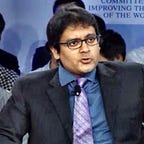Save the ‘Panel Discussion’ from Extinction — Seven Steps
It was put to me recently that panel discussions are congenitally boring and should be removed from the program of any self-respecting conference. I disagree.
It’s not the format that is at fault : the marginal differentiator is the quality of facilitation.
When it comes to moderators of ‘serious’ panels (where the topic has a technical bent), I see a spectrum of styles:
- There are experts who have distinguished themselves through publications but are perhaps less comfortable with the spoken word. They should really be a member of the panel but were assigned the moderator role as that was the ‘residual seat’ available.
- On the other end of the spectrum, there are professional presenters who lead with personality and style but perhaps less of a command over subject-matter.
I am of course exaggerating to make the general point: that the ideal cocktail of the two is few and far between.
So, what could save ‘panel discussions’ from extinctions? Here’s a straw-man* of seven points. (The videos are meant to be short clips, to watch for no more than 2 or 3 minutes, from the point that they start**) :
1. Moderator is key:
Program designers must recognize that the role of the moderator is a specialist one that has a determining effect on impact. It’s not a place to park the Nth specialist on the panel.
2. Preparation:
I spend much more time preparing for a moderator role than I do for a speaker role. It is important to understand all sides of the issue and how they connect. Not just the intro and conclusion, I think through transitions between speakers, in advance. Part of preparing is to speak to the panelists beforehand but there should always be scope for spontaneity and surprise.
3. All panels should be constructed as debates — whether they are explicitly set up as such or not.
Conflict is the essence of drama. But apart from drama, contrast between views help clarify those views and it is the job of the moderator to help flesh them out. A panel is not a discrete set of speeches. It is designed to be an interaction amongst diverse views. The moderator needs to facilitate that interaction, actively interrupting soliloquys that sail past each other.
4. Continuity through keyword.
During transitions, I like to repeat the key point to which I’m asking the succeeding panelist to respond. I also keep an eye on the “so what?” question. If someone makes a general point, take it through the last mile and ask why exactly it is relevant to the topic.
5. Involve the audience as early as possible
…and provide them with the flight-path of the session at the start, together with the destination.
I like to be able to call on some members of the audience by name as I do here and here.
6. Read body language.
I can’t do this well but I appreciate the value of observing non-verbal cues. Some panelists express dissent with folded arms and may require a timely nudge to vocalise it. The body language of the audience also provides real-time feedback on the tempo of proceedings.
7. Do not run out of time
..and abruptly bring the panel to a close. It’s important to land the plane at its destination and try make that landing memorable.
Finally, a successful discussion is one that continues way beyond the formal session. Ushers and security must be called in to clear people out.. :)
Appreciate all feedback.
- *I’m using youtube clips from two World Economic Forum events (Davos 2015, Summer Davos 2014) as illustrations. Both sessions were put together by Dr. Marjo Koivisto.
- **I know how to start youtube videos at a specific point. Does anyone know if I can also make them stop at another, designated point?
